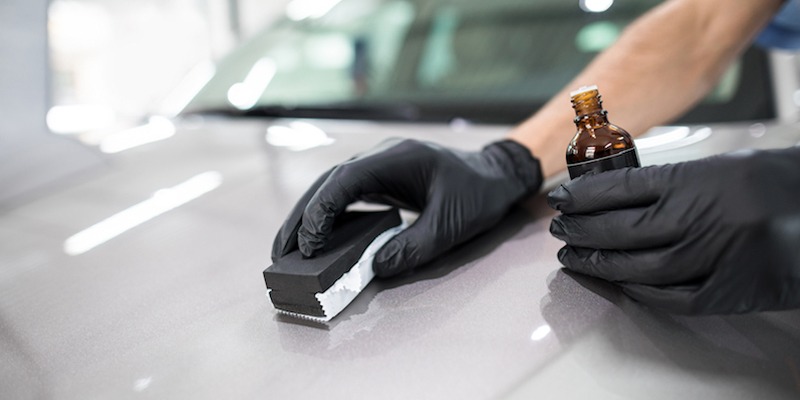Leading Reasons to Invest in Specialist Ceramic Coating for Your Car
Leading Reasons to Invest in Specialist Ceramic Coating for Your Car
Blog Article
Understanding the Science Behind Ceramic Coating for Improved Vehicle Durability
The science of ceramic finish is transforming lorry upkeep by providing a formidable guard against harsh environmental factors. As we explore the detailed make-up and application procedure of ceramic layers, we uncover the keys behind their premium protection and durability (ceramic coating). Just how does this contrast to standard approaches, and what ramifications does it have for vehicle upkeep in the lengthy term?

Composition of Ceramic Coatings
Ceramic finishes are mainly made up of silicon dioxide (SiO2), which is stemmed from natural products like quartz and sand. This substance develops the foundation of the finish, offering its particular solidity and resistance to ecological components. In addition to SiO2, ceramic coverings frequently include titanium dioxide (TiO2) for boosted UV protection and raised resistance to ecological toxins. These nanocomposite materials develop a robust, chemical bond with the automobile's surface, offering a long-lasting safety layer.
The formulation of ceramic coatings is a thorough procedure where the concentration of SiO2 can significantly affect the finishing's efficiency. Higher SiO2 content typically leads to better resilience and hardness, adding to the finish's ability to resist scratches and chemical etching. The balance of components is vital; as well much SiO2 can make the finish fragile, while too little can jeopardize its protective residential properties.
Makers may also integrate added compounds, such as polysilazane, to improve flexibility and simplicity of application. These additives improve the covering's hydrophobic properties, making certain water and pollutants grain off the surface area effortlessly. This engineered structure highlights the effectiveness of ceramic finishes in safeguarding a lorry's outside against a selection of unfavorable conditions.
Application Process Described
Using a ceramic layer to an automobile involves several essential actions, each necessary to ensuring optimum attachment and efficiency of the safety layer - ceramic coating. The procedure starts with a comprehensive clean and decontamination of the lorry's surface to eliminate dust, crud, and previous waxes or sealants. This step is critical as any contaminants left on the surface can prevent the coating's capacity to bond effectively
Complying with the initial cleansing, the next action includes brightening the vehicle to eliminate any imperfections, such as swirl marks or scratches. Sprucing up makes certain a smooth surface area, which is essential for the layer to stick properly and give a consistent coating. After brightening, a surface preparation spray is used to remove any type of continuing to be deposits and guarantee that the surface area is entirely tidy.

Safety Benefits
Typically hailed for its phenomenal protective top qualities, a ceramic covering provides many advantages that considerably boost automobile resilience. At its core, ceramic finish develops a hard, semi-permanent obstacle over a vehicle's outside, which acts as a shield against various ecological threats.
Furthermore, ceramic coatings exhibit hydrophobic properties, suggesting they fend off water and facilitate a self-cleaning impact. This attribute lowers the adherence of dirt and mud, streamlining upkeep and cleaning processes. The finish's resistance to chemical etching better makes sure that the lorry's surface stays unblemished regardless of direct exposure to severe cleaning agents and toxins.
In addition to these protective advantages, the ceramic finish enhances a lorry's aesthetic allure by creating a shiny surface that accentuates color depth and clearness. This not only maintains the vehicle's aesthetic charm yet also adds learn this here now to its lasting value by maintaining the stability of its outside in time.
Comparing to Conventional Techniques
Unlike typical approaches of lorry defense, such as shaving or sealants, ceramic layers use an even more long-lasting and durable option. Where waxes and sealants commonly give a momentary layer of protection, typically requiring reapplication every few months, ceramic coverings form a semi-permanent bond with the vehicle's paint. This bond creates a safety layer that is immune to environmental impurities, UV damages, and minor abrasions.
Conventional waxes are mostly made up of all-natural elements like carnauba wax, providing a glossy finish yet doing not have the robust protective high qualities of ceramic finishes. Sealers, while synthetic and offering a little better toughness than waxes, still drop brief in contrast to the durability and chemical resistance of ceramic finishes. The advanced technology of ceramic coatings integrates nanotechnology, which allows them to load in microscopic flaws in the paint surface, causing a smoother and extra hydrophobic coating.
In terms of application, ceramic layers require a more precise process, often requiring expert setup to make sure optimal efficiency. This contrasts with the fairly simple application of waxes and sealers, which can be applied at home. Nevertheless, the superior defense and visual enhancement supplied by ceramic layers justify the financial investment for those seeking long-term automobile conservation.
Longevity and Upkeep
How does the durability of ceramic coatings equate right into simplicity of upkeep for vehicle proprietors? The innovative formula of ceramic layers gives a robust protective layer on the car's surface area, which dramatically extends the life expectancy of the car's outside finish. This durability means that the layer serves as a guard versus environmental pollutants such as UV rays, bird droppings, and roadway gunk, which can or else degrade paintwork in time. As an outcome, lorries coated with ceramic items need less constant cleaning and detailing efforts, thus lowering maintenance time and expenses for owners.
In addition, the hydrophobic nature of ceramic finishings enables water and various other liquids to grain up and roll discover this off the surface area, lugging dirt and particles with them. While the covering itself is resilient, it is not totally maintenance-free. Therefore, ceramic coatings supply an important equilibrium between lasting resilience and simplified maintenance for automobile treatment.
Final Thought
Ceramic coatings, with their advanced chemical composition of silicon dioxide and titanium dioxide, provide a formidable obstacle versus ecological damage, considerably enhancing car longevity. The hydrophobic homes promote self-cleaning, lowering maintenance initiatives and preserving visual allure. When compared to standard techniques, ceramic finishes use exceptional protection versus UV rays, oxidation, look at more info and chemical etching. This innovation expands the life expectancy of car exteriors, making it a cutting-edge option for long-term conservation and minimal upkeep.
The formulation of ceramic layers is a meticulous procedure where the concentration of SiO2 can considerably affect the finishing's efficiency.Applying a ceramic finishing to a car entails several essential steps, each important to ensuring ideal adhesion and performance of the protective layer.Frequently hailed for its phenomenal safety high qualities, a ceramic covering uses numerous advantages that significantly enhance car durability. The sophisticated solution of ceramic coverings supplies a robust protective layer on the lorry's surface area, which dramatically extends the life-span of the automobile's outside surface.Ceramic finishings, with their innovative chemical make-up of silicon dioxide and titanium dioxide, provide a formidable obstacle against environmental damage, significantly enhancing vehicle sturdiness.
Report this page